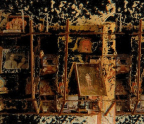What Are They Fighting For? On Oliver Husain, Kerstin Schroedinger, and the community who embraced DNCB as an experimental treatment for HIV

Among the most colourful (literally) of these hopes was dinitrochlorobenzene (DNCB): a common chemical used in the processing of colour photography that, starting as early as the mid-’80s, some HIV+ people experimented with to treat the virus—or at least reduce the appearance of lesions caused by Kaposi’s sarcoma (KS), an AIDS-related opportunistic infection. As a fact sheet about DNCB from the Canadian AIDS Treatment Information Exchange explains:
DNCB is applied to the skin where it is absorbed and carried to the lymph nodes by immune system cells. Within the lymph node network, DNCB is thought to stimulate several parts of the cell-mediated immune system—specifically the parts that are weakened in HIV disease. DNCB seems to prompt the cell-mediated immune system both to produce chemicals (called cytokines) that regulate the immune system and to increase specific immune cell levels. 1
Artists Kerstin Schroedinger and Oliver Husain illustrate the process of applying the chemical in the short film Contact Hypersensitivity (DNCB extract) (2019/2020). Starting amid the depth of a black screen, a soundtrack by artist and DJ Ain Bailey begins, setting the tone with a “dark, deep, warm” club vibe, as Husain describes it. The next thing we see is a spotlight upon a close crop of flesh, pressed into by a finger, its nail replete with polish. Upon its release, the surface of the body rebounds. This shot establishes a fact of our flesh: it resides within the thin protective organ of our skin, a porous layer upon which much can happen.
From there, Schroedinger and Husain explore topical possibilities of skin as it relates to DNCB. Against vibrant, shifting backgrounds of jewel tones and neons, a library of hands equipped with thin brushes and Q-tips paint and swab a gelatinous substance—evocative of DNCB, a powder which was then mixed with Vaseline or the like to be applied—onto a forearm, a back, a thigh. These application sites are often tinted and hued using makeup, sparkles, or body paint. For some, this might
You’re reading a preview, subscribe to read more.
Start your free 30 days





